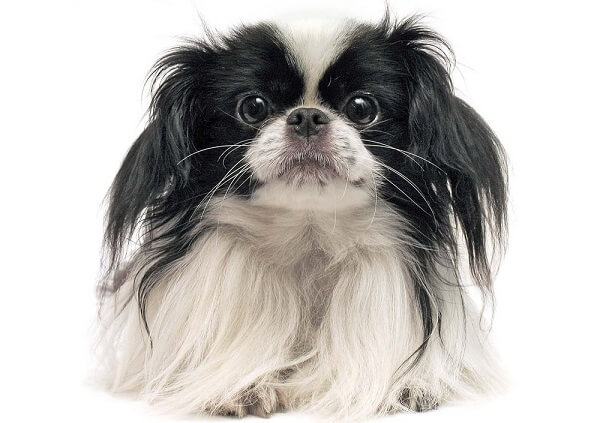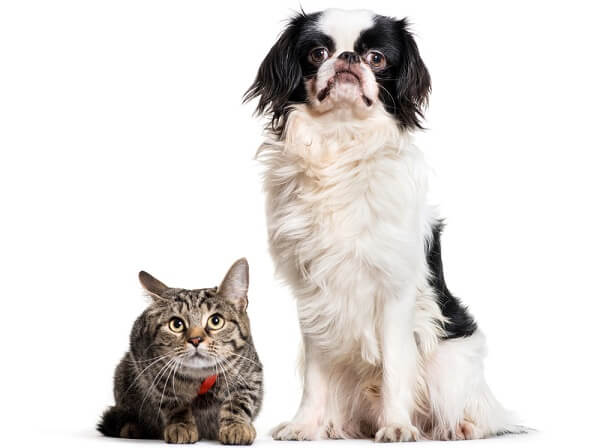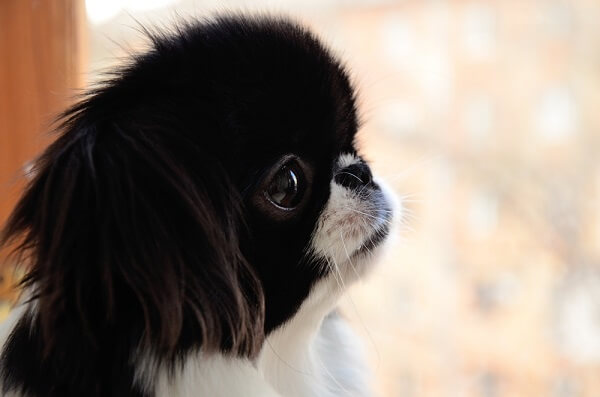
The Japanese Chin – sometimes called the Japanese Spaniel – is a small breed of domestic dog that makes a great companion animal and lap dog. As part of the Toy Group of dog breeds, the Japanese Chin has been bred to be a loyal pet and friend. Whereas many breeds were selected for specific tasks such as herding or tracking, the toy breeds were selected mostly for cute traits and a pleasant temperament. The Japanese Chin is unique because it actually has several traits in common with a cat. This breed can balance well, uses its front legs to clean its face, and will often climb furniture or other structures. Many owners note this curious high perching behavior as very similar to perching behaviors seen in cats. The exact history of the Japanese Chin is not fully known, with different people claiming different events as the true start of the breed. However, it is clear that this breed was very popular among Japanese royalty. Over time, the breed became a favorite fancy toy breed of many royal families and high-class breeders across the globe. While the Japanese Chin is not fully hypoallergenic, they do have a trait that decreases their shedding. Unlike most dog breeds, this breed does not have an undercoat. The undercoat of most dog breeds provides extra warmth, but it also is the source of a large amount of shedding. The Japanese Chin typically only has a soft, fluffy overcoat that only sheds seasonally in smaller amounts. The Japanese chin may be an adorable companion animal, but there is actually a lot about this breed that can teach us about bigger aspects of biology. Let’s take a look at a few biological concepts that the Japanese chin exhibits! Those crooked eyes sure are cute! This condition, called strabismus, happens when the eyes do not align or track together. In humans, this condition causes poor depth perception. Typically, the eyes work together to focus on the same point. Since the eyes are a short distance apart, the difference in the distance from each eye allows the brain to figure out exactly how far away an object is. With strabismus, the ability to detect distances through vision is greatly hindered. However, this does not seem to stop the chin from climbing and being fairly acrobatic. The dogs make up for their lack of perfect vision with excellent balance and an apparently fearless attitude towards heights. Many dog breeds are known as brachycephalic breeds. This word literally translates to “short head” – describing the drastically shortened snout and mouth compared to their wild counterparts. The Japanese chin is one of the most brachycephalic dogs that has been artificially selected, with their snout only sticking out a few inches at most. While this trait is adorable, it does have some drawbacks. Most brachycephalic breeds can easily get overheated. Since the snout in most dogs acts like a cooling mechanism for air entering the lungs, breeds with a very short snout have a harder time cooling air down. Larger breeds – like the Boxer – can easily overheat if they are overworked. While this does not seem to be an issue for the Chin, some dogs do end up with breathing or vision issues related to their shortened face. Amazingly, the Japanese Chin evolved from the same stock that produced all dog breeds – wolves. This fact shows the amazing power of artificial selection to change a breed over consecutive generations. But, artificial selection is not a perfect process. It often introduces many traits that detrimental, in addition to the traits that were selected for. In going from a wolf to a toy breed, breeders looked at many traits – like size, temperament, and shape. Since these massive evolutionary changes happened within such a short time frame (approximately 15,000 years), there were also lots of “hidden” detrimental traits that still affect the breed in negative ways. For instance, the Japanese Chin is prone to weak knee caps, dental problems, eye problems, and other ailments.
Kingdom
Animalia
Phylum
Chordata
Class
Mammalia
Order
Carnivora
Family
Canidae
Genus
Canis
Species
Canis familiaris
Niche
Domesticated
Height
8-11 in (20-28 cm)
Weight
7-11 lbs (3-5 kg)
Lifespan
10-12 years
Social Structure
Domesticated
Conservation Status
Least Concern
Preferred Habitat
Indoors
Average Litter Size
1-3 puppies
Main Prey Species
Dog Food
Predators
Vulnerable to predators like coyotes and raptors
The Basics

Fun Facts about the Japanese Chin!
Strabismus – Crooked Eyes

Brachycephalic – Smushy Face

From Wolves to Toys
